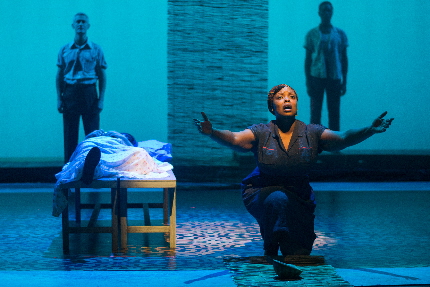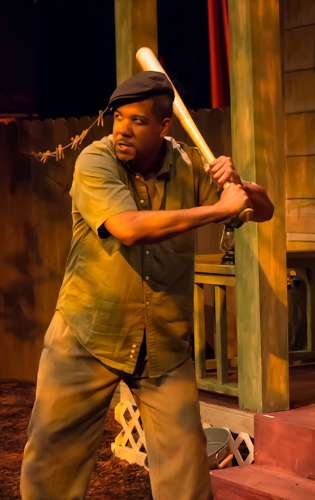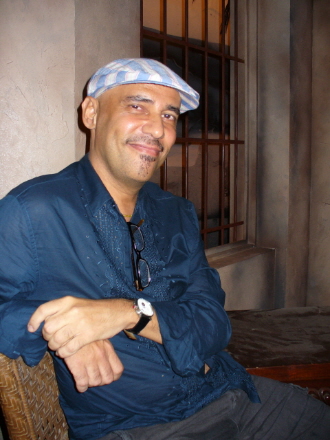
Diverse cultures were part of The Golem of Havana, one of Miami New Theatre’s early entries / / Photo by Jenny Abreau
By John Thomason
A few days after the 2019 Carbonell Awards this past April, Miami New Drama’s artistic director and co-founder, Michel Hausmann, phoned Carbonell judge Kent Wilson to discuss what had become the elephant in the Amaturo Theater: All of the winners in the performance and directing categories were white, as well as nearly every winning designer.
Surely, something was wrong with this picture, Hausmann argued, and it went beyond optics and toward theories of implicit bias. (Full disclosure: I am a Carbonell judge as well.) Perhaps Wilson, the only person of color on the 10-member Carbonell judging panel as well as president of the South Florida Theatre League, could empathize with what Hausmann has viewed, for some time, as a systemic problem of both recognition and opportunity.
“The Carbonells awarded 100 percent white winners this year,” Hausmann said, a few weeks later. “Last year it wasn’t the same, and I know people love to say that. (At the 2018 ceremony, four of the acting winners were African-American, and M Ensemble was also awarded statues for Best Director and Best Production of a Play.—Ed.) But then look at the previous 10 years.

Michel Hausmann
“As the theater field evolves and becomes younger and more representative of the diversity of the community, the judging system needs to reflect those changes as well. It needs to create a panel that looks like our city. Otherwise it risks being perceived as white supremacy,” Hausmann contended.
But this year’s Carbonells were simply the boiling point in a discussion that has long simmered behind the curtain of South Florida theater.
Where all sides seem to agree is that there isn’t a tremendous amount of work being produced by and for black and Hispanic talent, even though, at least in Miami, they constitute a vast majority population
As Wilson remembers the conversation, “Michel contacted me the day after, or two days after, the awards, and made the statement that there wasn’t enough diversity in the awards. My response was that while that may or not be true, you also have to look at the fact that we can only evaluate what’s presented to us. So if a theater, for instance, does a season of Neil Simon, and they cast it traditionally, there will be no diversity in those casts.”
“I gave it to him on this level: You really need to look at this from an artistic director standpoint, because you’re saying we’re not representing the community. But what do you mean by the community? Because I frequently go to theaters where I’m sitting in a 300-plus-seat theater, and I’m the only person of color in the audience. I’m constantly it if I go to the Maltz. I’m constantly it if I go to the Wick. I can be constantly it if I go to Thinking Cap depending on their season.”
Wilson recalled, “I said, I don’t know how much you, Michel, go out and see other productions, but yours is one of the few theaters across three counties whose audience represents the diversity that is South Florida. In most audiences it doesn’t happen, and it has a lot less to do with the productions themselves as the cost of going to a show. Let’s pick the Maltz, doing The Wiz, and I’m the only person of color in the audience, because most people of a working-class economic level cannot afford those tickets.
“There’s a lot of factors, and if you only see your theater, you need to be aware that your theater is unusual in our three-county-wide system. It’s different by age, by income, by ethnicity. It’s an odd bird. It’s great—I’m thrilled about it—but if you just go down to GableStage, it’s totally different.”
(Hausmann said “I think it’s a myth that people tell themselves that minorities don’t have a middle-class, and a dangerous myth,” citing that One Night in Miami “had a 40-percent African-American audience. Our last week had 70 percent. The show sold $170,000 dollars.”)
To support his argument, Wilson created a meticulous spreadsheet that deconstructed the racial makeup of all the productions at Carbonell-eligible theaters for 2018. Of 53 South Florida theater companies, only 26 met the requirements for Carbonell evaluation. Of the 1,057 actors, directors and designers credited in Carbonell-recommended shows, Wilson classified only 211 as “non-white.” It stands to reason that only a small percentage of these contributors, just like the broad pool of candidates, will qualify as Carbonell-worthy.
“Let’s say I’m in a show, and let’s say I’m nominated,” Wilson said. “I hope I’m being nominated because I’m being recognized for the work I did, and not because of the color of my skin. The award would be hollow to me if you just gave it to me because I was the only black kid on the stage.”

Nicholas Richberg
Carbonell-winning actor Nicholas Richberg, who has produced theater as the former managing director of Zoetic Stage, shares Hausmann’s belief that diversity in South Florida theater is a pivotal issue facing the community. “The percentage of winners probably is proportional to the eligible work.”
Which raises the question of eligible work,” he said. “I’ve heard it said that some judges feel like, I can’t go to a show that’s bilingual because I don’t understand it. Aside from that, certainly from a judging perspective, you connect to things differently based on your life experience. It’s not a matter of prejudice or racism. That’s color, that’s ethnicity, that’s age.
“It’s so hard to get around to see all the shows, and have the time, and have a job that allows you to do it,” he added. “Maybe the system is rigging it for a demographic you don’t want. But this isn’t about making recommendations to the Carbonell Awards; my issue is only as an example of what our community looks like—and sitting in the room [for the ceremony] and feeling like I could have been in Dayton, Ohio.”
* * * * *
Wilson isn’t the only judge Hausmann contacted to voice his concerns; he has reached out to Mary Damiano, managing director of the Carbonells, and veteran critic Christine Dolen as well. He has become this community’s most outspoken advocate against a perceived imbalanced theater environment that favors Anglo talent from soup to nuts—from show selection to casting to awards consideration. Depending on to whom you speak, he’s either creating division or exposing it.

Ethan Henry in M Ensemble’s Fences
Miami New Drama is the most vocal exception to the idea that there is a dearth of diverse-centric work. Diversity has been integral to Hausmann’s mission since the company’s debut production of The Golem of Havana in 2016. Likewise, M Ensemble and the African-American Performing Arts Community Theatre have been serving African-American theater artists and playgoers for 47 and 21 years, respectively. The International Hispanic Theatre Festival of Miami will return for its 34th iteration in April. Little Havana’s Teatro Avante has focused specifically on providing Spanish-language theater since its inception in 1978 by Mario Ernesto Sánchez. Newer companies like Micro Theater Miami, Arca Images and Juggerknot cater to multi-ethnic theater but are not up for awards consideration.
“The Carbonells are only a reflection of our theater community,” said Hausmann, who was born in Venezuela and received his theater education at Emerson and Columbia. “In Dade County, 11 percent of Miami-Dade County is white Anglo. That is the exact same relationship of whites in South Africa. If you look at the theater scene, at the established theaters—and some of them are my friends—it feels as if it is made by that 11 percent for that 11 percent. It feels that there is a myopia of living here and not really seeing our demographic.
“I’ll tell you why that is extremely dangerous,” he added. “Because when young people of color go to a theater and they don’t see themselves reflected onstage time after time, you are inadvertently telling them that their narrative is not as important as white people’s narratives. It’s a disservice.
“I get so passionate about it, because I feel the danger. I’m very aware of the national conversations in theater, and I’m appalled by the fact that Miami is living in the Stone Age. Can you please explain to me, in what other city in America do the three largest companies all have shows directed by white males, and 90 percent of them are written by white males? There wouldn’t be any other city where someone wouldn’t stop and say, ‘there’s something going on.’”
“It’s about points of view,” added Richberg, who is Cuban-American. “Over the years I have recognized as an actor that I always am passed as a non-Hispanic person. That’s for two reasons. One reason is I don’t fit the idea that most people have of what a Hispanic person looks like, sounds like and acts like. And that’s as much an indictment of white non-Hispanics as it is Hispanics themselves, to an extent. The other reason is that the work just isn’t produced.
“I always think about the kid going to the theater, like I did, in South Florida, and seeing a show and thinking to themselves, hey, I could do that. I could be that person up there. If it’s going to seem exotic to them, like some museum piece about some mythical white family that argues in their living room, then are we discouraging a generation of artists not only to create and to become theater artists, but to stay in South Florida—to think this is a place that I could actually stay and work.
“I so often hear it said, and I know as a producer who’s cast shows with Hispanic characters, that it’s not easy to find actors who can fill these roles sometimes. It seems ridiculous to say that in Miami, but it’s absolutely true. And it’s because so many actors of color leave Miami, because the work just isn’t there, or because they think the work isn’t there, or they think the possibility doesn’t exist.”

Nilo Cruz
Nilo Cruz, South Florida’s most celebrated Hispanic playwright, who currently runs Arca Images, has actually seen opportunities for theater artists of color decrease, despite the demographic data. “I think it’s like that everywhere in the United States,” he said. “When I was living in New York in the ‘90s and the beginning of the new century, I noticed there was more of an impetus to do multicultural theater, and I find that somehow, later on, that started to decline. I think it is still in decline in the present moment. I don’t see as much representation nowadays.
“I think theaters need to not just program plays that are written by writers of different backgrounds, but they need to go into the communities—Hispanic and black communities—and really try to invite those audiences to the theater. Because it isn’t just about presenting the work. People need to know that the work exists. This doesn’t mean that if you do a play by a Latino writer, that most of the audience members need to be Latino. I certainly do write for Latinx actors, because it gives them a platform, but I write plays for the world. I don’t target an audience.”
For Hispanic playwrights in South Florida, the chance to be produced by a respected theater company can seem especially daunting, recalling the old Ginger Rogers chestnut that to be cast in a film, a woman needed to do everything that a man did, but do it backwards and in high heels.
“The only theater that has produced my work when I was starting as a playwright was New Theatre,” Cruz said. “It wasn’t until much later that my work was embraced by Coconut Grove Playhouse, when they did Anna in the Tropics and Bicycle Country. Even to be on the main stage of Coconut Grove Playhouse, it took for me to win a Pulitzer Prize for my play to be staged. In the meantime, my work was being done at very prestigious theaters in other parts of the United States.”
* * * * *
As for Hausmann’s reference to the “three largest companies [in Miami that] all have shows directed by white males,” we can all infer which those companies are. Two of those artistic directors agreed to be interviewed about whether they believe Hausmann’s concerns have merit, and if they’re doing enough to support the communities he believes are disenfranchised.
“A theater should have a DNA that reflects the people who are running the theater and who set the mission,” said Joseph Adler, producing artistic director of GableStage. “Obviously, that is affected by who they are and where they’re from, their race, their religion, their country of origin, by a lot of things. The bottom line is, that probably does have something to do with the choices you make.
“It is incumbent upon us, still, to try and reach out—which I’ve been trying to do. The next play we’re doing is an entire black cast, by a female black playwright. I look at my seasons for 21 years, and I think we always try to do at least one play of the six, and usually more than that, that have a black sensibility, usually by a black playwright, with often an all-black cast. We did Ruined, with like 19 black actors and one white one.
“I do think we have an obligation to try to be inclusive,” he added. “But I don’t think that means we have to have a quota. I credit Michel for what he’s doing, and I understand his sensibilities, and mine are obviously different. Were I Venezuelan, I might be saying what he’s saying.”
“I can’t disagree with [Michel] 100 percent, but of course, I would push back,” said David Arisco, artistic director of Actors’ Playhouse. “Our efforts for years have been to include the Hispanic and black populations as much as we can in all our programming. Multi-ethnicity in our staff, in our casting, in everything we do—we’ve been doing that since the early days. But it is difficult when a community is 70 percent Hispanic and someone like Michel might observe that there’s maybe more white theater going on than Hispanic theater. That doesn’t mean there are not efforts being made.”
For Actors’ Playhouse, this has meant productions as varied as Four Guys Named Jose and a Mujer Named Maria, the regional professional premiere of Lin-Manuel Miranda’s In the Heights, Carlos Lacamara’s Havana Bourgeois, Nilo Cruz’s The Color of Desire and, most recently, the multiple Carbonell-nominated Havana Music Hall, a world premiere.
Then there have been his company’s three productions of Evita, the most recent of which, in 2017, included a full Spanish-language run, even though it was not a financial success for the theater. “We found out that a lot of the bilingual, Spanish-speaking people who wanted to see Evita wanted to see it in English,” Arisco said. “The weekends were great, but the weeknights were very difficult for us to find that audience. Even at the end of the run, we talked about how this was not a failure, that it was part of our mission and our need.
“It’s something we’ve felt strongly about for years, and that’s the only objection I have. When a young theater company believes that they’re the only ones doing it, or that it’s not being done enough, I don’t blame them for thinking that. Because they’re focusing on presenting Hispanic playwrights with Hispanic directors with Hispanic themes all the time. We still have to appreciate the fact that we do have a large Anglo audience, as much as we’re trying to build, every day of our existence, the Hispanic audience in Miami—especially the second generation, who are completely bilingual. … You need to get them in the door with a theme that will ignite them, and then hopefully they come back and become addicted to theater, period.”
Hausmann, for all of his advocacy on this issue, is beginning to see positive changes. “I started this company three years ago with a budget of about $300,000 a year,” he recalled. “My budget now is almost $3 million. The success of projects that embrace the diversity that we have is proof enough that we are in the beginning of the dawn of a new moment, where there is a level of connection and excitement for people who before had never felt invited to the theaters.
“We don’t want to be a theater company; we want to be an institution,” he said, adding that Miami New Drama will soon be the only certified LORT theater south of the Maltz. (The League of Resident Theatres is the largest theater organization in the United States, and is involved with, among other things, collective bargaining with theater unions.) “We’ve come to realize that theater of color is the trend that is taking over Miami.”
Multicultural theater is also the driving focus of this year’s Theatre Communications Group national conference, hosted in Miami’s InterContinental hotel June 5-7. Hausmann campaigned to host the conference in the Magic City and is heavily involved in its production, from selecting the host committee to producing the opening-night party to participating in a panel on bilingual work. Among the guest speakers of color are Edwidge Danticat, critic Wesley Morris, Nilo Cruz, and playwright Quiara Alegría Hudes. Some of this year’s programming includes “Women of Color in the Community: Cocktails and Conversation,” “Theaters of Color Breakfast” and “Anti-Racist Resources for White People.”
Some in the community feel Hausmann is trying to swing the pendulum too far in the opposite direction, but they declined to be interviewed on the record. Many others are in his camp.
“This is definitely not a Michel crusade,” Richberg said. “This is something that is frequently spoken about, and frequently eye-rolled about. It’s something that has long simmered within segments of the theater community. It’s tough, because at the end of the day, the majority of the theater community is made up of artists, not of producers, and artists want to work. And artists don’t want to offend the people who are going to give them work. So it’s not common for artists who depend on producers for work to speak up about what they see as lack of representation. Most artists are in that difficult decision of not wanting to ruffle feathers, or to seem like the ‘angry black woman’ or the ‘mean Latino guy’ or the person who cried foul because they’re bitter they didn’t win some award or get cast in some show. It’s a tough position to be in.
“At the end of the day, this is not an issue that is unique to South Florida,” he added. “People were complaining a few weeks ago about the Tonys and how all the judges are old. And there was #OscarsSoWhite. However, I think South Florida is in a unique position to address it. That’s why I think it’s important to have the conversation—if we all can get over our egos and our internal biases to acknowledge that we all hold an important piece of the mosaic, one that has the potential to be richer and more colorful than anywhere else in the country.”








 A PaperStreet Web Design
A PaperStreet Web Design
